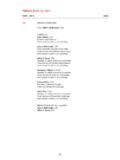Transcription of Steven Patterson April 5, 2017 OCLWA 2017 Stillwater
1 Steven Patterson April 5, 2017 OCLWA 2017 Stillwater What can we learn from this recent work? A limnologist s approach to numerical lake modeling: a case study at Lake Wister, OK (Thad Scott, baylor university ) Reconstructing water quality conditions using Reservoir Limnology Theory: An empirical approach to phosphorus load reduction estimates for Beaver Lake, Arkansas (Matthew W. Rich, Beaver Water District and university of Arkansas and J. Thad Scott, baylor university ) Model My Watershed-- a new, user-friendly, online modeling platform (Anthony Aufdenkampe, LimnoTech) Fine-scale (HUC 12) watershed sampling to complement or in place of watershed modeling (Brad Austin and Brian Haggard, university of Arkansas) Learning from recent modeling projects results of a survey (Shanon Phillips, Oklahoma Conservation Commission, and Steve Patterson , Bio x Design) Panel discussion with session speakers-- Improving modeling practice for water quality improvement A limnologist s approach to numerical lake modeling: a case study at Lake Wister, OK (Thad Scott, baylor university ) Reconstructing water quality conditions using Reservoir Limnology Theory: An empirical approach to phosphorus load reduction estimates for Beaver Lake, Arkansas (Matthew W.)
2 Rich, Beaver Water District and university of Arkansas and J. Thad Scott, baylor university ) Model My Watershed-- a new, user-friendly, online modeling platform (Anthony Aufdenkampe, LimnoTech) Fine-scale (HUC 12) watershed sampling to complement or in place of watershed modeling (Brad Austin and Brian Haggard, university of Arkansas) Learning from recent modeling projects results of a survey (Shanon Phillips, Oklahoma Conservation Commission, and Steve Patterson , Bio x Design) Panel discussion with session speakers-- Improving modeling practice for water quality improvement A limnologist s approach to numerical lake modeling: a case study at Lake Wister, OK (Thad Scott, baylor university ) Reconstructing water quality conditions using Reservoir Limnology Theory: An empirical approach to phosphorus load reduction estimates for Beaver Lake, Arkansas (Matthew W.
3 Rich, Beaver Water District and university of Arkansas and J. Thad Scott, baylor university ) Model My Watershed-- a new, user-friendly, online modeling platform (Anthony Aufdenkampe, LimnoTech) Fine-scale (HUC 12) watershed sampling to complement or in place of watershed modeling (Brad Austin and Brian Haggard, university of Arkansas) Learning from recent modeling projects results of a survey (Shanon Phillips, Oklahoma Conservation Commission, and Steve Patterson , Bio x Design) Panel discussion with session speakers-- Improving modeling practice for water quality improvement The uses of models Types of models The uses of models Understanding Management TMDLs ODEQ: Models provide a linkage between loads and receiving waters Models allow the testing of various load reduction scenarios Types of models Physical models Conceptual models Empirical models Process-based models Numerical simulation models Physical models Army Corps of Engineers Bay-Delta Model Sausalito, CA Imerito 2013.
4 Dynamic Reservoir Simulation Model: DYRESM v4; Science Manual, Centre for Water Research, university of Western Australia. Flow diagram of the P cycle and its interaction with algal biomass in ELCOM-CAEDYM Numerical simulation models Lake Wister ELCOM-CAEDYM tracer inflow studies. Scott et al. Limnology & Oceanography 1974. 19(5): 767-773. Empirical models Fischenich 2008. Application of conceptual models to ecosystem restoration. ERDC TN-EMRRP-EBA-01. US Army Engineer Research and Development Center. Conceptual models Ecosphere 2013. 4(2): 1-12. Process-based models Ecosphere 2013. 4(2): 1-12. Process-based models Built on transparent assumptions and processes Wolfe, , DePinto, Dilks, and Slawecki. Presented at the Bay Delta Science Conference, Sacramento, CA. October 30, 2014. Operational Ecosystem Modeling to Support Adaptive Management Lessons from 40 Years of Decision Support in the Great Lakes Questions?
5






